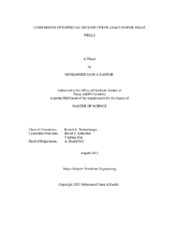| dc.description.abstract | This study compares four recently developed decline curve methods and the traditional Arps or Fetkovich approach. The four methods which are empirically formulated for shale and tight gas wells are:
1. Power Law Exponential Decline (PLE).
2. Stretched Exponential Decline (SEPD).
3. Duong Method.
4. Logistic Growth Model (LGM).
Each method has different tuning parameters and equation forms. The main objective of this work is to determine the best method(s) in terms of Estimated Ultimate Recovery (EUR) accuracy, goodness of fit, and ease of matching. In addition, these methods are compared against each other at different production times in order to understand the effect of production time on forecasts. As a part of validation process, all methods are benchmarked against simulation.
This study compares the decline methods to four simulation cases which represent the common shale declines observed in the field. Shale wells, which are completed with horizontal wells and multiple traverse highly-conductive hydraulic fractures, exhibit long transient linear flow. Based on certain models, linear flow is preceded by bilinear flow if natural fractures are present. In addition to this, linear flow is succeeded by Boundary Dominated Flow (BDF) decline when pressure wave reaches boundary. This means four declines are possible, hence four simulation cases are required for comparison.
To facilitate automatic data fitting, a non-linear regression program was developed using excel VBA. The program optimizes the Least-Square (LS) objective function to find the best fit. The used optimization algorithm is the Levenberg-Marquardt Algorithm (LMA) and it is used because of its robustness and ease of use.
This work shows that all methods forecast different EURs and some fit certain simulation cases better than others. In addition, no method can forecast EUR accurately without reaching BDF. Using this work, engineers can choose the best method to forecast EUR after identifying the simulation case that is most analogous to their field wells. The VBA program and the matching procedure presented here can help engineers automate these methods into their forecasting sheets. | en |


